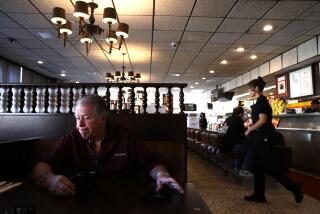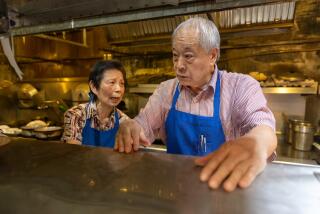A Grand Central Market makeover? It could work
At 9 a.m. sharp, the man in the blue blazer swung a brass bell over his head, a rite that dates back to the Grand Central Market’s opening day in 1917. A minute later, nearly every swivel chair at the China Cafe counter was filled, mostly by older men hunched over bowls of wonton soup.
“It’s not a fancy place,” said Concepcion Orellano, 57. “People come here because they are poor.”
Owner Rinco Cheung, an experienced restaurateur and Hong Kong native, confided he didn’t know what chop suey was until he took over China Cafe from his wife’s cousin last year.
“It’s very old-style,” Cheung said, pointing out the menu boards overhead, which list several “egg fo yeung” dishes the owner also didn’t recognize. “They love it like that,” he added.
Which is precisely the problem. I too love the Grand Central Market: its Beaux Arts touches, the flowing script of the neon signs at each stall, the weird store names — “Jones Grain Mill” — the exposed pipes and pendant light fixtures.
And I’m a fan of the back-in-the-day comfort food and retro prices in the cavernous food hall between Broadway and Hill streets. On Friday, (small) avocados were on sale at one of the produce stands seven for $1, and Jose’s Ice Cream Corner had cones for $1.50. The market, with its mix of Mexican, Chinese, Japanese and Middle Eastern food, is one of the last holdouts of the $5-or-less lunch plate in downtown Los Angeles.
But landmarks cannot live on nostalgia alone. And even the most militant preservationist has to see it’s time to shake up the venerable food emporium. Downtown’s population has exploded, but the Grand Central Market clearly is failing to bring in many of its new, upscale urbanistas. Last week, I saw more vacant space than I can remember at any point in the last decade.
Alarms went off after The Times reported on the planned makeover by Adele Yellin, president of the development company started by her late husband, Ira. The news bounced around the blogosphere, drawing complaints about a loss of authenticity. Times staff writer Joseph Serna denounced the gentrification of the “people’s market.”
The minds behind the chichi Ferry Building, a foodie mecca in San Francisco, are involved; a consultant told Times reporter Betty Hallock his “fantasy” is a pocket cafe or sushi bar under the stairs.
The consternation seems somewhat misplaced. The basement’s tenants now are a passport photo place and one of those ubiquitous 99-cent-style discount stores; I doubt they’ll be missed much.
But our history of slash-and-burn urban renewal does not give comfort. It brings to mind the Vietnam War tag line: We had to destroy the village to save it.
Bunker Hill was flattened. Nothing was preserved of the magnificent Ambassador Hotel when Los Angeles Unified converted it to a public school. Instead, the district built kitschy facsimiles of the hotel’s Paul R. Williams-designed coffee shop and Cocoanut Grove nightclub. The once-glamorous Brown Derby icon sits atop a strip mall in Koreatown, robbed of any history or meaning.
I talked to Yellin and her developer, Rick Moses, and I believe they are sincere about maintaining the character of the market. After all, her late husband kept his promise not to make the place “Westside cute” during an earlier overhaul in the 1990s. The changes thus far are modest: the sawdust was removed, and the floors, pipes and ceiling are being scrubbed and polished.
“Yes, we want to clean it up, but we don’t want to change the feel of it,” Moses told me.
But how about also committing to structuring rents so that at least some portion of the market’s offerings remain affordable?
It’s only fair. The public has a sizable stake in the Grand Central Market. Local agencies financed $44 million in bonds for Ira Yellin’s renovation of the historic market and the Homer Laughlin Building above it. The market today still owes the Metropolitan Transportation Authority and the now-defunct L.A. Community Redevelopment Agency $32 million, Moses said.
People come downtown not simply for its historic charm, but because it’s a beautiful mess — a hodgepodge of what came before, what’s hot now, grit, glitz and authenticity.
Retired computer systems engineer Daniel Kerr took the train in from San Clemente to visit the China Cafe on Friday for the wonton soup but also to take in the action.
“I like city life,” he said. “There’s so much to see and to do. it’s just interesting.” Being on a fixed income, he’ll probably have to cut back on the China Cafe if a meal there goes up to $10 or more, he said.
“I think it’s so cool here,” said Adrian Aguilar, 25, an El Monte native who recently moved into a loft downtown. “I love sushi, but this is just like straight from the streets of L.A.”
Aguilar, tattooed and dressed head to toe in black, said he had musician friends coming in from New York and was “all excited to bring them to places like this.”
Moses and Yellin say there is no intention to purge existing tenants, just to fill the holes. As a sign of good faith, they recently signed Las Morelianas, of pig snout taco fame, to a new lease.
Cheung kept the old menu and employees when he took over the China Cafe. This, along with his beer license, the only one in the market, undoubtedly helped him hang on to old customers. He has high hopes the new style can blend with the old. “Why not mix it all together?” he said.
What a concept: a real mixed-used project.
More to Read
Sign up for Essential California
The most important California stories and recommendations in your inbox every morning.
You may occasionally receive promotional content from the Los Angeles Times.










